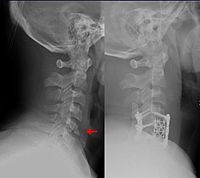
Photo from wikipedia
Background: Disorders of the hip and lumbar spine can create similar patterns of pain and dysfunction. It is unknown whether all surgeons, regardless of orthopedic or neurosurgery training, investigate and… Click to show full abstract
Background: Disorders of the hip and lumbar spine can create similar patterns of pain and dysfunction. It is unknown whether all surgeons, regardless of orthopedic or neurosurgery training, investigate and diagnose concurrent hip and spine pathology at the same rate. Methods: Data were retrieved from Taiwan’s National Health Insurance Research Database (NHIRD). Enrolled patients were stratified into hip and spine surgery at the same admission (Both), hip surgery before spine surgery (HS), or spine surgery before hip surgery (SH). The SH group was further subdivided based on whether spine surgery was performed by an orthopedic surgeon (OS) or neurosurgeon (NS), and differences in preoperative radiographic examinations and diagnoses were collected and analyzed. Results: In total, 1824 patients received lumbar spine surgery within 1 year before or after hip replacement surgery. Of these, 103 patients had spine and hip surgery in the same admission (Both), 1290 patients had spine surgery before hip surgery (SH), and 431 patients had hip surgery before spine surgery (HS). In the SH group, patients were categorized into spine surgery by orthopedic surgeons (OS) (n = 679) or neurosurgeons (NS) (n = 522). In the SH group, orthopedic surgeons investigated hip pathology with X-rays more often (52.6% vs. 38.1%, p < 0.001) and diagnosed more cases of hip disease (43.6% vs. 28.9%, p < 0.001) than neurosurgeons. Conclusions: Of patients in Taiwan’s NHIRD who had concurrent surgical degenerative hip and lumbar spine disorders who had spine surgery before hip surgery, orthopedic surgeons obtained hip images and made hip-related diagnoses more frequently than did neurosurgeons.
Journal Title: Brain Sciences
Year Published: 2021
Link to full text (if available)
Share on Social Media: Sign Up to like & get
recommendations!